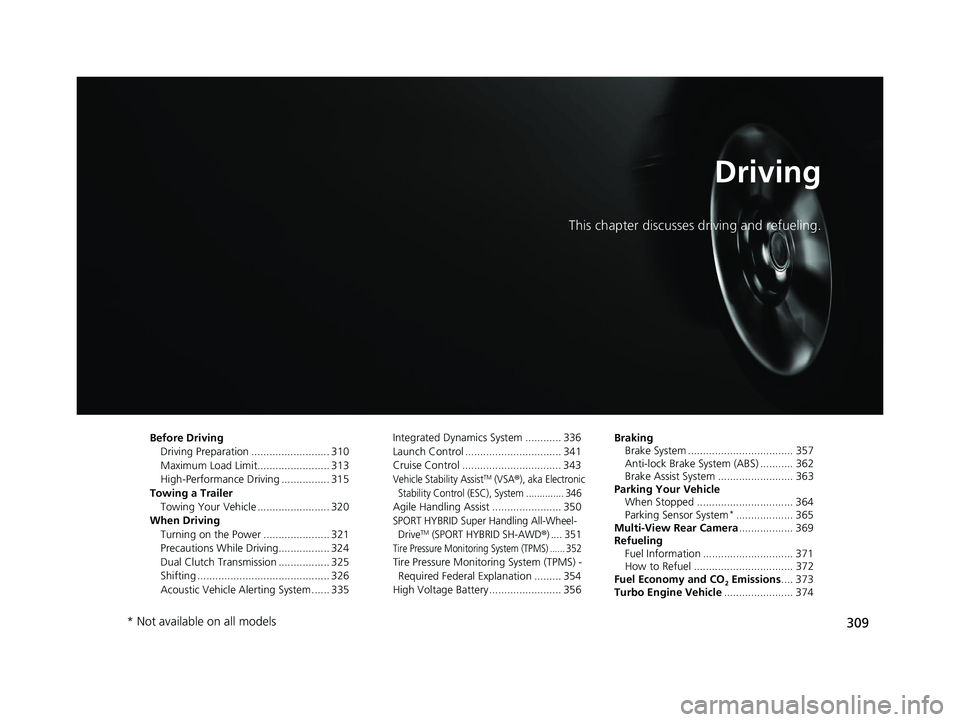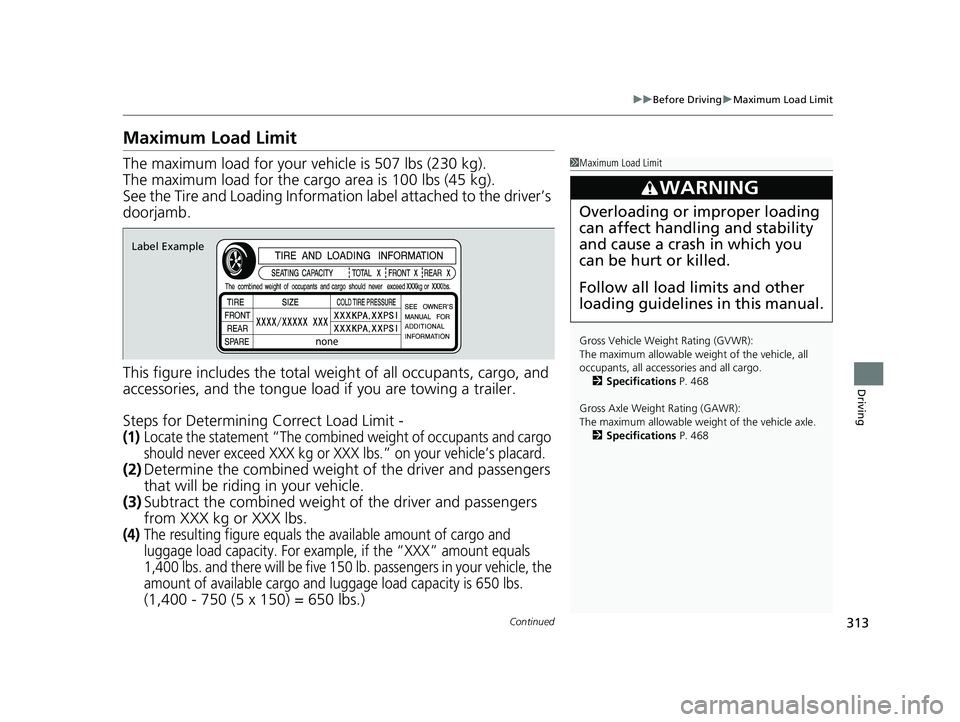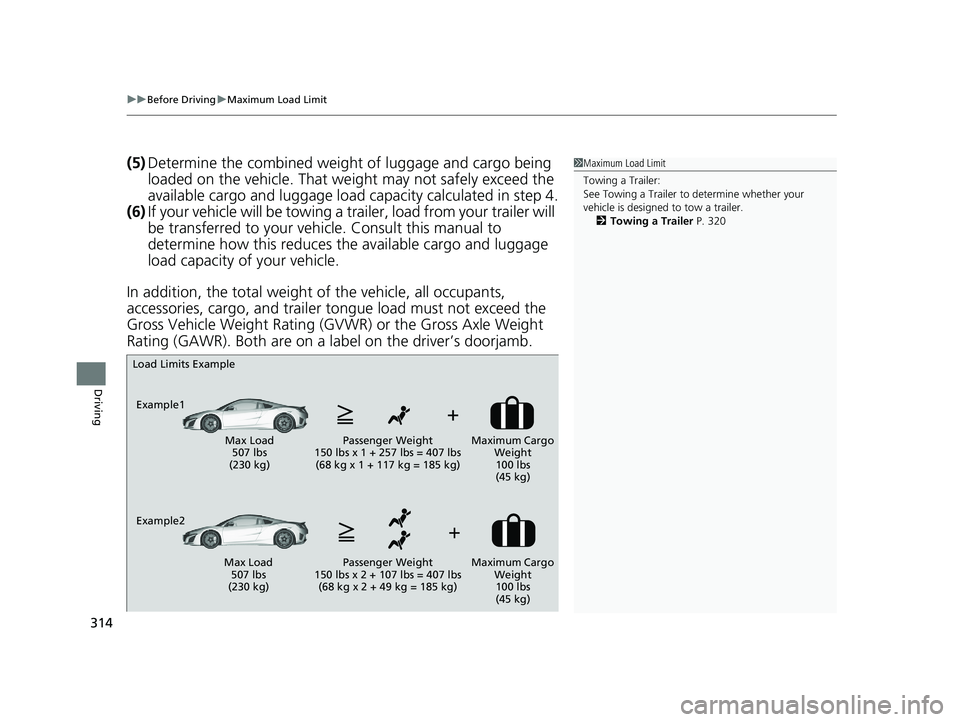ACURA NSX 2020 Owners Manual
Manufacturer: ACURA, Model Year: 2020, Model line: NSX, Model: ACURA NSX 2020Pages: 491, PDF Size: 20.24 MB
Page 311 of 491

309
Driving
This chapter discusses driving and refueling.
Before Driving Driving Preparation .......................... 310
Maximum Load Limit........................ 313
High-Performance Driving ................ 315
Towing a Trailer Towing Your Vehicle ........................ 320
When Driving Turning on the Power ...................... 321
Precautions While Driving................. 324
Dual Clutch Transmission ................. 325
Shifting ............................................ 326Acoustic Vehicle Al erting System ...... 335 Integrated Dynamics System ............ 336
Launch Control ................................ 341
Cruise Control ................................. 343
Vehicle Stability AssistTM (VSA®), aka Electronic
Stability Control (ESC), System .............. 346
Agile Handling Assist ....................... 350
SPORT HYBRID Super Handling All-Wheel- DriveTM (SPORT HYBRID SH-AWD®) .... 351
Tire Pressure Monitoring System (TPMS) ...... 352
Tire Pressure Monitoring System (TPMS) - Required Federal Explanation ......... 354
High Voltage Battery ........................ 356 Braking
Brake System ................................... 357
Anti-lock Brake System (ABS) ........... 362
Brake Assist System ......................... 363
Parking Your Vehicle
When Stopped ................................ 364
Parking Sensor System *
................... 365
Multi-View Rear Camera .................. 369
Refueling
Fuel Information .............................. 371
How to Refuel ................................. 372
Fuel Economy and CO 2 Emissions
.... 373
Turbo Engine Vehicle ....................... 374
* Not available on all models
20 ACURA NSX PMC-31T6N6300.book 309 ページ 2019年9月11日 水曜日 午後4時51分
Page 312 of 491

310
Driving
Before Driving
Driving Preparation
Check the following items before you start driving.
• Make sure there are no obstructions on the windows, door mirrors, exterior
lights, or other parts of the vehicle.
uRemove any frost, snow, or ice.
uRemove any snow on the roof, as this can slip down and obstruct your field of
vision while driving. If frozen solid , remove ice once it has softened.
uWhen removing ice from around the wheels, be sure not to damage the wheel
or wheel components.
• Make sure the hood is securely closed.
uIf the hood opens while driving, your front view will be blocked.
• Make sure the tires are in good condition.
uCheck air pressures, and check for damage and excessive wear.
2 Checking and Maintaining Tires P. 407
• Make sure there are no people or ob jects behind or around the vehicle.
uThere are blind spots from the inside.
• Check the front bumper ducts and side intercooler ducts for mud, leaves, and
road debris that could build up and prevent proper cooling performance.
■Exterior Checks1Exterior Checks
NOTICE
When doors are frozen s hut, use warm water around
the door edges to melt any ice. Do not try to force
them open, as this can damage the rubber trim
around the doors. When done, wipe dry to avoid further freezing.
Do not pour warm water into the key cylinder.
You will be unable to insert the key if the water
freezes in the hole.
Heat from the engine and exhaust can ignite
flammable materials left und er the hatch, causing a
fire. If you’ve parked y our vehicle for an extended
period, inspect and remove any debris that may have
collected, such as dried grass and leaves that have
fallen or have been carried in for use as a nest by a
small animal.
Also check under the hatch for leftover flammable
materials after you or so meone else has performed
maintenance on your vehicle.
20 ACURA NSX PMC-31T6N6300.book 310 ページ 2019年9月11日 水曜日 午後4時51分
Page 313 of 491

Continued311
uuBefore DrivinguDriving Preparation
Driving
•Store or secure all items on board properly.
uCarrying too much cargo, or improperly storing it, can affect your vehicle’s
handling, stability, sto pping distance, and tires, and make it unsafe.
2 Maximum Load Limit P. 313
• Do not pile items higher than the seat height.
uThey can block your view and may be thrown forward in the event of sudden
braking.
• Do not place anything in the seat footwe lls. Make sure to secure the floor mat.
uAn object or unsecured floor mat can interfere with your brake and accelerator
pedal operation while driving.
• If you have any animals on board, do not let them move around in the vehicle.
uThey may interfere with driving and a crash could occur.
• Securely close and lock both doors and the hatch.
2 Locking/Unlocking the Doors from the Inside P. 115
• Adjust your seating position properly.
2 Adjusting the Seats P. 144
• Adjust the mirrors and steering wheel properly.
uAdjust them while sitting in the proper driving position.
2 Adjusting the Mirrors P. 141
2 Adjusting the Steering Wheel P. 140
■Interior Checks1Interior Checks
The headlight aim is set by the factory, and does not
need to be adjusted. Howeve r, if you regularly carry
heavy items in the trunk ha ve the aiming readjusted
at an authorized Acura NS X dealer or by a qualified
technician.
20 ACURA NSX PMC-31T6N6300.book 311 ページ 2019年9月11日 水曜日 午後4時51分
Page 314 of 491

312
uuBefore DrivinguDriving Preparation
Driving
•Be sure items placed on the floor behind the driver’s and passenger’s seats cannot
roll under the seats.
uThey can interfere with the driver’s ability to operate the pedals, the operation
of the seats, or the operation of the sensors under the seats.
• Everyone in the vehicle must fasten their seat belt.
2 Fastening a Seat Belt P. 39
• Make sure that the indicators in the instrument panel come on when you start the
vehicle, and go off soon after.
uAlways have an authorized Acura NSX d ealer check the vehicle if a problem is
indicated. 2 Indicators P. 70
20 ACURA NSX PMC-31T6N6300.book 312 ページ 2019年9月11日 水曜日 午後4時51分
Page 315 of 491

313
uuBefore DrivinguMaximum Load Limit
Continued
Driving
Maximum Load Limit
The maximum load for your vehicle is 507 lbs (230 kg).
The maximum load for the carg o area is 100 lbs (45 kg).
See the Tire and Loading Information label attached to the driver’s
doorjamb.
This figure includes the total weig ht of all occupants, cargo, and
accessories, and the tongue load if you are towing a trailer. Steps for Determining Correct Load Limit -
(1)Locate the statement “The combined weight of occupants and cargo
should never exceed XXX kg or XXX lbs.” on your vehicle’s placard.
(2)Determine the combined weight of the driver and passengers
that will be riding in your vehicle.
(3) Subtract the combined weight of the driver and passengers
from XXX kg or XXX lbs.
(4)The resulting figure equals the available amount of cargo and
luggage load capacity. For exampl e, if the “XXX” amount equals
1,400 lbs. and there will be five 150 lb. passengers in your vehicle, the
amount of available cargo and luggage load capacity is 650 lbs.
(1,400 - 750 (5 x 150) = 650 lbs.)
1Maximum Load Limit
Gross Vehicle Weight Rating (GVWR):
The maximum allowable weight of the vehicle, all
occupants, all accesso ries and all cargo.
2 Specifications P. 468
Gross Axle Weight Rating (GAWR):
The maximum allowable weight of the vehicle axle. 2 Specifications P. 468
3WARNING
Overloading or improper loading
can affect handling and stability
and cause a crash in which you
can be hurt or killed.
Follow all load limits and other loading guidelines in this manual.
Label Example
20 ACURA NSX PMC-31T6N6300.book 313 ページ 2019年9月11日 水曜日 午後4時51分
Page 316 of 491

uuBefore DrivinguMaximum Load Limit
314
Driving
(5) Determine the combined weight of luggage and cargo being
loaded on the vehicle. That we ight may not safely exceed the
available cargo and luggage load capacity calculated in step 4.
(6) If your vehicle will be towing a trailer, load from your trailer will
be transferred to your vehicl e. Consult this manual to
determine how this reduces th e available cargo and luggage
load capacity of your vehicle.
In addition, the total weight of the vehicle, all occupants,
accessories, cargo, and trailer tongue load must not exceed the
Gross Vehicle Weight Rating (GVW R) or the Gross Axle Weight
Rating (GAWR). Both are on a label on the driver’s doorjamb.1Maximum Load Limit
Towing a Trailer:
See Towing a Trailer to determine whether your
vehicle is designed to tow a trailer.
2 Towing a Trailer P. 320
Load Limits Example
Example1 Max Load 507 lbs
(230 kg) Passenger Weight
150 lbs x 1 + 257 lbs = 407 lbs (68 kg x 1 + 117 kg = 185 kg) Maximum Cargo
Weight 100 lbs
(45 kg)
Example2 Max Load 507 lbs
(230 kg) Passenger Weight
150 lbs x 2 + 107 lbs = 407 lbs (68 kg x 2 + 49 kg = 185 kg) Maximum Cargo
Weight 100 lbs
(45 kg)
20 ACURA NSX PMC-31T6N6300.book 314 ページ 2019年9月11日 水曜日 午後4時51分
Page 317 of 491

315
uuBefore DrivinguHigh-Performance Driving
Continued
Driving
High-Performance Driving
Your Acura NSX is designed, built and equipped with systems and features to
provide you with exceptional driving performa nce, including the ability to engage in
high-performance driving. Ho wever, due to the risks to both you and other road
users, including the risk of injury or death from a high-speed loss of control or crash,
if you engage in high-performance driving, Acura recommends you only do so
where conditions are controlled, such as at a track or other closed-course venue.
When driving on public roads you should always obey the posted speed limits and
other traffic laws, reduce speed as needed for traffic and environmental conditions,
and not engage in driving behaviors (includi ng, for instance, use of Launch Control)
that may create heightened risks for your self and any other road users who may be
present (even if you are unaware of them). NSX TRACK mode, Launch Control and other systems are designed for increased
performance, both in terms of accelerati on and handling, up to near-performance-
limit conditions. They are most appropriat ely used on closed courses and they should
not be used on public roads. Use of these systems may delay the intervention of
vehicle safety systems designed to minimize the risk of a loss of traction or steering
control, and can cause the NSX to handle differently than you might expect or
would experience under normal driving conditions. Use of these systems will not
make up for a lack of appropriate driver experience and skill, and will not allow the
driver to overcome risks created by: • A lack of proper vehicle maintenance
• Less than ideal road conditions and/or unfamiliarity with the driving environment
• Other traffic or road users
1High-Performance Driving
NOTICE
The NSX warranty does not cover any damage or
failure resulting from hi gh-performance driving,
racing, competitive driving of any sort whatsoever, or
use on a track or similar-type venue. See warranty
book for details.
2 TRACK Mode P. 340
2 Launch Control P. 341
20 ACURA NSX PMC-31T6N6300.book 315 ページ 2019年9月11日 水曜日 午後4時51分
Page 318 of 491

316
uuBefore DrivinguHigh-Performance Driving
Driving
High-performance driving requires special skills, knowledge and experience, as the
safety risks are greatly increased when the NSX is operated at its upper performance
abilities. As a responsible NSX driver, you should not drive above your skill limits or
training, even if the NSX’s performance leve ls would otherwise allow you to do so.
If you intend to engage in high-performa nce driving, Acura strongly recommends
that: • You first obtain appropriate, professional training
• Turn off any devices or systems that may distract you from the driving task
High-performance driving in general, and the use of TRACK mode and Launch
Control in particular, puts very high loads on the NSX and its components, and
results in greater wear and tear on the vehicl e. Because of these high loads, if your
NSX is not in top condition or if certain com ponents, such as the brakes or tires, have
undue wear, those components could experience a loss of performance, or fail,
when engaging in high-performance drivin g. Therefore, Acura highly recommends
that you undertake more proactive and frequent maintenance than that required
under normal use and have your vehicle inspected at an authorized Acura NSX
dealer (and all necessary repairs or adju stments made) before you engage in any
high-performance driving. In addition to any required maintenance, there are
certain NSX specific items and protocols th at you should pay special attention to
before, during and after engaging in any high-performance driving. Ultimately, the
decision whether to engage in high-perfo rmance driving is yours, and depending on
your NSX’s condition and prior usage, the items and protocols listed below may or
may not be sufficient to ensure a safe driving experience.
BEFORE DRIVING •With the vehicle parked on level gro und, properly bleed brake system after
replacing with Acura Heavy Duty Brake Fluid DOT 4 or equivalent
• Inspect brake pad thickness an d replace if 6.0 mm or less
20 ACURA NSX PMC-31T6N6300.book 316 ページ 2019年9月11日 水曜日 午後4時51分
Page 319 of 491

Continued317
uuBefore DrivinguHigh-Performance Driving
Driving
•Burnish the brake pads shortly before high -performance driving so that they have
the performance characteristics necessary to repeatedly and quickly slow the NSX
when it is being operated at signific antly high speeds. (While the NSX’s brake
pads are properly burnished for the demands expected in ordinary day-to-day driving, high-performance driving puts unique demands on the brake system
which require further burnishing.)
• Inspect ALL cooling openings to confirm th ey are open and free of debris such as
leaves, etc. Cooling openings include engine undercover ducts, heat resistance
ducts, brake ducts, radi ators, and intercoolers
• Remove Tire Repair Kit from the trunk, along with any other cargo area contents
• Check tire wear and tire pressure, and m ake certain wheel lug bolts are properly
torqued, as driving at high speed puts additional strain on tires and wheels. Never
use slick tires, and do not use Summer Only tires and Ultra High Performance tires
if temperatures will be lower than 45°F (7°C)
• If you anticipate sustained driving at speeds greater than 168 mph/270 km/h,
adjust the cold tire pressure as shown on the driver door jamb warning label. This
will help avoid heat build-up and sudden tire failure1High-Performance Driving
3WARNING
Use of slick tires/racing slicks may subject the chassis and body components to higher
dynamic loads than they were designed for.
Higher than intended dynamic loads could
result in component fail ure, loss of control,
and serious injury or death to you or others.
Do not install slick tires on the NSX.
Canadian models
U.S. models
20 ACURA NSX PMC-31T6N6300.book 317 ページ 2019年9月11日 水曜日 午後4時51分
Page 320 of 491

318
uuBefore DrivinguHigh-Performance Driving
Driving
•Inspect all exhaust mounts for cracks or signs of wear
• Inspect tailpipe active exhaus t valves to ensure they are functioning correctly. You
can do this by cycling the Integrated Dynamics System mode switch between
SPORT and TRACK modes, while the engine is idling
WHILE DRIVING• You may see a brake warning message in the Driver Information Interface (and
warning message chime) and/or expe rience increased brake pedal stroke.
If either occurs, immediately slow do wn and allow for increased stopping
distances. The message will disappear once the brakes have cooled and the
system has returned to normal operating condition
• After high-performance driving, it is critic al to allow your vehicle to properly cool
down. Do not immediately stop your vehicle. Instead, continue driving at reduced
speeds, allowing for increased braking di stances until your vehicle returns to
normal operating temperatures. Once you stop and safely park the NSX, open the
hatch to aid cooling. If the engine oil temperature reaches the mark during
high-performance driving, have your NSX inspected by an authorized Acura NSX
dealer
H
20 ACURA NSX PMC-31T6N6300.book 318 ページ 2019年9月11日 水曜日 午後4時51分